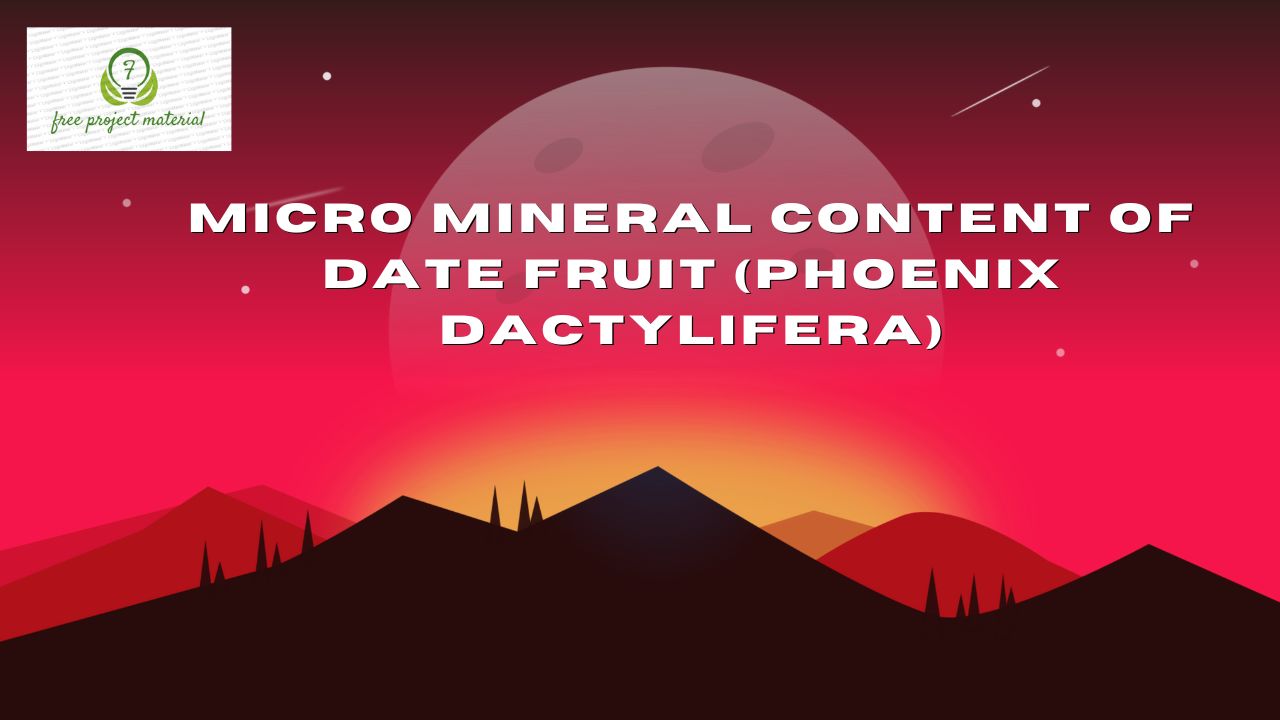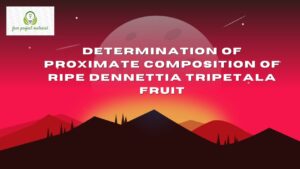ABSTRACT
This study was on micro mineral content of date fruit was carried out using standard analytical method. The result of the study revealed the following: Manganese (0.539 ± 0.0176 mg/100g), Iron (1.319 ± 0.0042 mg/100g), Zinc (0.485 ± 0.0181 mg/100g), Copper (0.708 ± 0.0091 mg/100g) and Chromium 0.271 ± 0.0212 mg/100g). Date fruits are good source of essential elements. However, the concentration of each of the elements though lower than the WHO permissible limit.
TABLE OF CONTENTS
Title Page – – – – – – – – – i
Certification – – – – – – – – – ii
Dedication – – – – – – – – – iii
Acknowledgements – – – – – – – iv
Abstract – – – – – – – – – v
Table of Contents – – – – – – – – vi-vii
CHAPTER ONE: INTRODUCTION
1.1 Background of the Study – – – – – – 1-3
1.2 Aim and Objectives of the Study – – – – 3
1.3 Scope and Limitation of the Study – – – – 4
1.4 Definition of Terms – – – – – – 4
CHAPTER TWO: LITERATURE REVIEW
2.1 Date Fruits – – – – – – – – 5-6
2.2 Date Fruits Types – – – – – – – 6-7
2.3 Uses – – – – – – – – – 7-8
2.3.1 Culinary Uses – – – – – – – 8
2.3.2 Medicinal Uses – – – – – – – 9
2.4 Types of Micro Mineral and Food Sources – – – 10
2.5 Function/Uses of Microminerals – – – – – 11-12
2.6 Deficiencies of Microminerals – – – – – 13-15
2.7 Recommended Dietary Intake for Micronutrients – – 15-17
CHAPTER THREE: MATERIALS AND METHODS
3.1 Materials and Reagents – – – – – – 18
3.2 Sample Collection and Preparation – – – – 18
3.3 Sample Analysis- – – – – – – – 19
3.3.1 Digestion of the Sample – – – – – – 19
3.3.2 Determination of the Sample- – – – – – 19-20
CHAPTER FOUR: RESULTS AND DISCUSSION
4.1 Results – – – – – – – – 21
4.2 Discussion – – – – – – – – 21-23
CHAPTER FIVE: CONCLUSION AND RECOMMENDATION
5.1 Conclusion – – – – – – – – 24
5.2 Recommendation – – – – – – – 24
References
CHAPTER ONE
1.0 INTRODUCTION
1.1 Background of the Study
The date palm (Phoenix dactylifera L.) is one of mankind’s oldest cultivated plants and has been used as food for about 6000 years (Sahari et al., 2007). It is an important food crop in middle East and is considered to be one of the most important fruit tree particularly. in North African, the Middle Eastern and Asian countries the fruits contributes to the economy and social life within these regions (Bastway et al., 2008). And it is consider as a tital component of their diet (Vayal, 2002). Date fruits are well known as a staple nutritious food and source of wealth for many years (Khan et al., 2008. Because of its high nutritional value, great yields and its long life, the date palm has been mentioned as the “tree of life” (Augstburger et al., 2002). The fruits of the date palms are consumed throughout the world. Dates are being consumed in modern cultures for the pleasant flavor, odor and their biting texture in addition to their use for flavoring foods, beverages and medication (Vayali, 2002).
Date fruits are the staple food of the middle East and very popular in Islamic countries. The nutritional value and its health benefits are well known across the globe due to rich in high profile nutrients and health promoting properties. Date palm (Phoenix dactylifera L.) is a multipurpose tree providing, fiver, carbohydrates, minerals and vitamins beside having certain medicinal properties (Vayalil, 2002; Al-Farsi et al., 2005). Date fruits are the products of date palm tree, belonging to the family of Arecaceae. It is one of the oldest cultivated plants in the world (Al-Shahib and Marshall, 2003), and is the must important subsistence crop in all Northern Africa and the middle East although it is also cultivated in other plants of the world. Worldwide production of date fruit has increased almost threefold production of date reaching 7.68 million tons in 2010 (Shahib and Marshall, 2003). Dates are loaded of various nutrients with medicinal importance for ailment of certain diseases. Because of its high nutritional value and its long life the date palm has been mentioned as the ‘tree of life’ (Augstburger et al., 2002). Whole part of dates are useful, also the by products arising from date processing can be used for different purposes. Dates are also used as food preparations like sweets, snacks, confectionary, baking products, Institutional Feeding and Healthy foods. There wholesome savory taste of all natural sugar invites the most culinary creativity. As an ingredient to any recipe, dates provide the perfect natural alternative to added sugar. Wonderfully delicious, dates are one of the most popular fruits packed with an impressive list of essential nutrients, vitamins and minerals that are required for normal growth, development and overall well-being. It is the sources of natural sugar like glucose, fructose and sucrose that furnishes body with instant energy.
1.2 Aim and Objectives of the Study
The aim of this study is to examine the micro-mineral composition of date fruit.
The Objectives of the Study are;
- To determine the micro-mineral in date fruit
- To compare the result of this study with previous studies and standard (RDA)
- To make useful recommendation base in the result of this study
1.3 Scope and Limitation of the Study
The study focus on only micro-mineral composition of date fruit, due to time and financial constraint.
1.4 Definition of Terms
Micro-Mineral: Micro-mineral is a chemical element required as an essential nutrient by organisms to perform functions necessary for life.
Medicinal Plant: It is any plant which in one or more of its organs, contain substances that can be used for therapeutic purposes or which are precursors for the synthesis of useful drugs.
Nutrition: It is the nourishment or energy that is obtained from food consumed or the process of consuming the proper amount of nourishment and energy. Am example of nutrition is the nutrients found in fruits and vegetables.
Food Supplements: These are concentrated sources of nutrients (i.e mineral and vitamins). Common supplements include vitamins (such as multi vitamins or individual vitamins like vitamin D and biotin). Minerals (such as calcium, magnesium and iron). Botanical or herbs (such as Echinacea and ginger).



